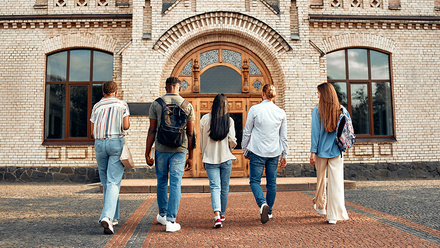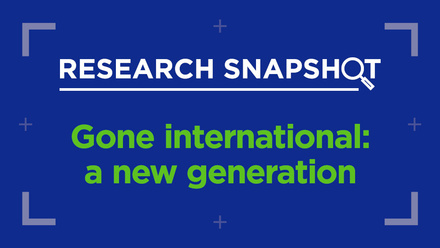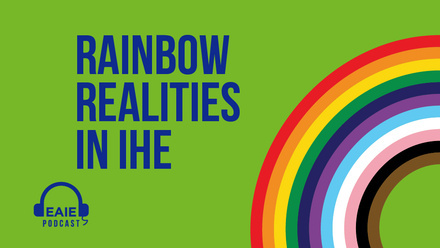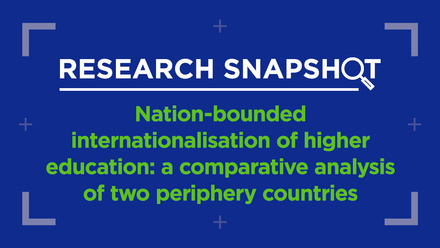Breaking down barriers to make physical mobility possible for all

One result of the COVID-19 pandemic has been an intensified focus on virtual mobility opportunities. Simultaneously, global conversations about diversity, equity, inclusion and belonging within higher education have become common.
Virtual mobility opportunities represent an important means of enabling access for students who have historically been excluded from physical international mobility opportunities, but more can be done to address these inequities. Creating change that enables physical mobility opportunities to be a viable option for equity-deserving student such as those with disabilities, requires an emphasis on student support, a removal of historical and structural barriers, and a willingness to re-examine the underlying rationale within our international agreements.
The University of Waterloo’s AccessAbility Services and Global Learning teams – which work on accommodation and operationalisation of international exchange agreements, respectively – forged a novel partnership in 2020 to enable a reconsideration of traditional exchange opportunities within a human rights framework. Supported by a Canada Outbound Student Mobility Innovation grant, we engaged over 1000 students with disabilities as paid contributors to the design and development of resources aimed at removing disability-related barriers to international exchange. Their insights expanded our awareness of the importance of identifying and addressing the needs of students from an intersectional, human rights perspective and provoked us to consider the historical constraints inherent within exchange partnerships.
Universally accessible
Accommodating difference is often the strategy used to enable a person with a disability to mitigate barriers. However, the goal should be to create systems that do not require that accommodation. A universally accessible approach is fundamental in creating environments where everyone benefits from the enhanced accessibility features of a space or system, including within international exchange.
A universally accessible approach is fundamental in creating environments where everyone benefits from the enhanced accessibility features of a space or system.
While the project identified the information and support needs of students with disabilities, it was evident that this information and support would be beneficial to all students. Many students who do not identify as having a disability still benefit from access to information that enables them to make informed decisions that promote their wellness and safety while abroad.
While students with disabilities require support in building a nuanced understanding of destinations and of differences in academic culture related to their academic, housing and other accommodation needs, all students benefit from information about an exchange destination’s culture, amenities and support. We are not encouraging the removal of disability from the discussion; we are encouraging normalised discussions related to disability and wellness that are likely to benefit all students.
Intersectionality
Student participants expressed distinctly that disability was only one facet of their identity, and that their experiences were impacted by the intersectionality of disability with other aspects such as their race, sexual orientation and gender.
Like all travellers, students make pragmatic decisions about destinations based on myriad identity markers. We learned from racialised students with disabilities that they feared prejudice and heightened surveillance when crossing borders at home and abroad with large quantities of necessary medication. We learned from transgender students with disabilities that it is critical for their sense of safety and wellness to only consider destinations where their gender identity and gender expression can be affirmed and protected.
Failing to acknowledge and address the intersectionality of student identities, and the impact that has on their ability to engage in an exchange, will prevent them from attempting such a journey.
Breaking down barriers
Students with disabilities experience myriad barriers that prevent them from even considering an exchange opportunity. The barriers are interpersonal, structural, procedural and systemic. It is important to determine which barriers are arbitrary and should be removed, and which barriers are more difficult or impossible to ameliorate. We learned that many barriers were in place as a result of convenience, tradition or well-intended beliefs, which contribute to systemic exclusion.
We learned that many barriers were in place as a result of convenience, tradition or well-intended beliefs, which contribute to systemic exclusion.
This project created an opportunity to identify and remove the most pressing barriers. For example, some students identified that a significant barrier to exchange was the lack of detailed information about disability support at a host school and destination. It was clear that the information traditionally offered to students assumed that those without disabilities were the default travellers. By reframing the image of our prospective exchange student, we were better able to determine the information relevant to them, thereby enabling them to make informed decisions on whether exchange was viable for them.
Other barriers are not within our control: for example, most students noted concerns about accessing necessary medication abroad. While we can’t provide better access to medication, we can ensure that prospective students understand the risks, have access to resources to determine whether they can plan safely to meet their medication needs, and are able to use this information to select exchange locations that may work for them.
Further barriers, such as course load requirements, grade average requirements and other eligibility criteria, may appear neutral and essential, but when examined from a disability and human rights framework, it becomes clear that many students are excluded by design, and that design can and should be questioned. In considering barriers, it is important to consider access – who is included and excluded from beneficial opportunities? Who benefits and who loses out from exemption criteria? What latitude do we have to consider alternatives?
Equity and access lens
As conversations regarding equity, diversity and inclusion are becoming embedded in our work, we note that these concepts are not equal in achieving a desired outcome. While concepts like inclusivity and diversity assist in calling people in, they do not necessarily require that we disrupt the status quo to remove unnecessary barriers that prevent access.
While concepts like inclusivity and diversity assist in calling people in, they do not necessarily require that we disrupt the status quo.
By applying an equity and access lens to our work, we can reflect on all of our roles in this work: How long has it been since we looked at the real value and perceived value of international exchange and considered whether these reflect the realities of all students? If we truly value the benefits of full cultural immersion, are we not obliged to continuously improve access for all? Can we make allowances within the scope of our partnerships that target the needs of students with disabilities as well as other intersectional identity categories? Can we vet our international agreements as well as our operational practice with a clearer eye towards ensuring a broader section of students can be supported and can thrive?
Aiming for belonging and the promotion of human rights requires internationalisation professionals to collaborate more closely with others across campus who have not traditionally been involved in internationalisation work. Tremendous expertise exists within disability offices, offices that support racialised students and offices and services that support 2SLGBTQIA+ students , and among students themselves. While this project aimed to identify and remove barriers to exchange for students with disabilities, we became more acutely aware of the importance of addressing the needs of students from an intersectional, human rights perspective. By embedding equitable internationalisation practices within the institution, we are better able to reflect on important questions about equity and belonging for all students.






